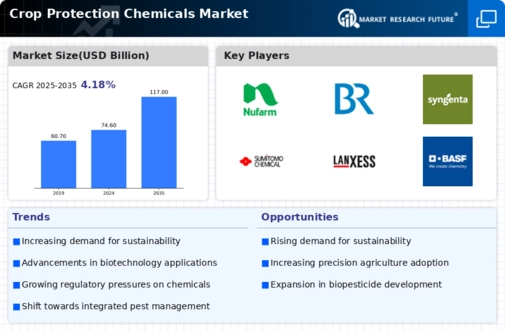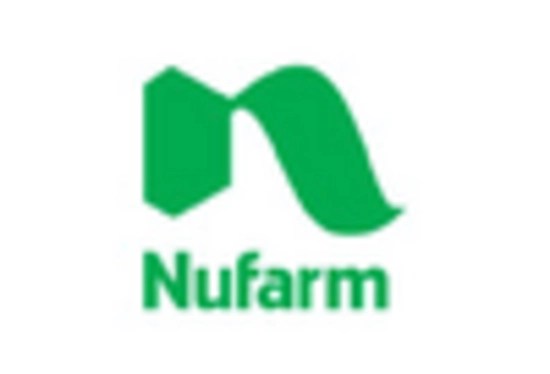-
EXECUTIVE SUMMARY
-
Market Overview
-
Key Findings
-
Market Segmentation
-
Competitive Landscape
-
Challenges and Opportunities
-
Future Outlook
-
\r\n
-
MARKET INTRODUCTION
-
Definition
-
Scope of the study
- Research Objective
- Assumption
- Limitations
-
\r\n
-
RESEARCH METHODOLOGY
-
Overview
-
Data Mining
-
Secondary Research
-
Primary Research
- Primary Interviews and Information Gathering Process
- Breakdown of Primary Respondents
-
Forecasting Model
-
Market Size Estimation
- Bottom-Up Approach
- Top-Down Approach
-
Data Triangulation
-
Validation
-
\r\n
-
MARKET DYNAMICS
-
Overview
-
Drivers
-
Restraints
-
Opportunities
-
\r\n
-
MARKET FACTOR ANALYSIS
-
Value chain Analysis
-
Porter's Five Forces Analysis
- Bargaining Power of Suppliers
- Bargaining Power of Buyers
- Threat of New Entrants
- Threat of Substitutes
- Intensity of Rivalry
-
COVID-19 Impact Analysis
- Market Impact Analysis
- Regional Impact
- Opportunity and Threat Analysis
-
\r\n
-
CROP PROTECTION CHEMICALS MARKET, BY TYPE (USD BILLION)
-
Fungicides
-
Insecticides
-
Herbicides
-
Others
-
\r\n
-
CROP PROTECTION CHEMICALS MARKET, BY CROP TYPE (USD BILLION)
-
Cereal & Grains
-
Fruits & Vegetables
-
Oilseed & Pulses
-
Others
-
CROP PROTECTION CHEMICALS MARKET, BY MODE OF APPLICATION (USD BILLION)
-
Soil Treatment
-
Seed Treatment
-
Foliar Spray
-
Others
-
CROP PROTECTION CHEMICALS MARKET, BY REGIONAL (USD BILLION)
-
North America
- US
- Canada
-
Europe
- Germany
- UK
- France
- Russia
- Italy
- Spain
- Rest of Europe
-
APAC
- China
- India
- Japan
- South Korea
- Malaysia
- Thailand
- Indonesia
- Rest of APAC
-
South America
- Brazil
- Mexico
- Argentina
- Rest of South America
-
MEA
- GCC Countries
- South Africa
- Rest of MEA
-
\r\n
-
COMPETITIVE LANDSCAPE
-
Overview
-
Competitive Analysis
-
Market share Analysis
-
Major Growth Strategy in the Crop Protection Chemicals Market
-
Competitive Benchmarking
-
Leading Players in Terms of Number of Developments in the Crop Protection Chemicals Market
-
Key developments and growth strategies
- New Product Launch/Service Deployment
- Merger & Acquisitions
- Joint Ventures
-
Major Players Financial Matrix
- Sales and Operating Income
- Major Players R&D Expenditure. 2023
-
COMPANY PROFILES
-
Nufarm
- Financial Overview
- Products Offered
- Key Developments
- SWOT Analysis
- Key Strategies
-
Hong Wen Chemical
- Financial Overview
- Products Offered
- Key Developments
- SWOT Analysis
- Key Strategies
-
Bayer
- Financial Overview
- Products Offered
- Key Developments
- SWOT Analysis
- Key Strategies
-
Nantong Jiangshan Chemical
- Financial Overview
- Products Offered
- Key Developments
- SWOT Analysis
- Key Strategies
-
Syngenta
- Financial Overview
- Products Offered
- Key Developments
- SWOT Analysis
- Key Strategies
-
ADAMA
- Financial Overview
- Products Offered
- Key Developments
- SWOT Analysis
- Key Strategies
-
Sumitomo Chemical
- Financial Overview
- Products Offered
- Key Developments
- SWOT Analysis
- Key Strategies
-
FMC
- Financial Overview
- Products Offered
- Key Developments
- SWOT Analysis
- Key Strategies
-
Isagro
- Financial Overview
- Products Offered
- Key Developments
- SWOT Analysis
- Key Strategies
-
Helena AgriEnterprises
- Financial Overview
- Products Offered
- Key Developments
- SWOT Analysis
- Key Strategies
-
Dow
- Financial Overview
- Products Offered
- Key Developments
- SWOT Analysis
- Key Strategies
-
Lanxess
- Financial Overview
- Products Offered
- Key Developments
- SWOT Analysis
- Key Strategies
-
BASF
- Financial Overview
- Products Offered
- Key Developments
- SWOT Analysis
- Key Strategies
-
UPL
- Financial Overview
- Products Offered
- Key Developments
- SWOT Analysis
- Key Strategies
-
Corteva
- Financial Overview
- Products Offered
- Key Developments
- SWOT Analysis
- Key Strategies
-
APPENDIX
-
References
-
Related Reports
-
\r\n
-
LIST OF TABLES
-
\r\n
-
LIST OF ASSUMPTIONS
-
NORTH AMERICA CROP PROTECTION CHEMICALS MARKET SIZE ESTIMATES & FORECAST, BY TYPE, 2019-2035 (USD BILLIONS)
-
NORTH AMERICA CROP PROTECTION CHEMICALS MARKET SIZE ESTIMATES & FORECAST, BY CROP TYPE, 2019-2035 (USD BILLIONS)
-
NORTH AMERICA CROP PROTECTION CHEMICALS MARKET SIZE ESTIMATES & FORECAST, BY MODE OF APPLICATION, 2019-2035 (USD BILLIONS)
-
NORTH AMERICA CROP PROTECTION CHEMICALS MARKET SIZE ESTIMATES & FORECAST, BY REGIONAL, 2019-2035 (USD BILLIONS)
-
US CROP PROTECTION CHEMICALS MARKET SIZE ESTIMATES & FORECAST, BY TYPE, 2019-2035 (USD BILLIONS)
-
US CROP PROTECTION CHEMICALS MARKET SIZE ESTIMATES & FORECAST, BY CROP TYPE, 2019-2035 (USD BILLIONS)
-
US CROP PROTECTION CHEMICALS MARKET SIZE ESTIMATES & FORECAST, BY MODE OF APPLICATION, 2019-2035 (USD BILLIONS)
-
US CROP PROTECTION CHEMICALS MARKET SIZE ESTIMATES & FORECAST, BY REGIONAL, 2019-2035 (USD BILLIONS)
-
CANADA CROP PROTECTION CHEMICALS MARKET SIZE ESTIMATES & FORECAST, BY TYPE, 2019-2035 (USD BILLIONS)
-
CANADA CROP PROTECTION CHEMICALS MARKET SIZE ESTIMATES & FORECAST, BY CROP TYPE, 2019-2035 (USD BILLIONS)
-
CANADA CROP PROTECTION CHEMICALS MARKET SIZE ESTIMATES & FORECAST, BY MODE OF APPLICATION, 2019-2035 (USD BILLIONS)
-
CANADA CROP PROTECTION CHEMICALS MARKET SIZE ESTIMATES & FORECAST, BY REGIONAL, 2019-2035 (USD BILLIONS)
-
EUROPE CROP PROTECTION CHEMICALS MARKET SIZE ESTIMATES & FORECAST, BY TYPE, 2019-2035 (USD BILLIONS)
-
EUROPE CROP PROTECTION CHEMICALS MARKET SIZE ESTIMATES & FORECAST, BY CROP TYPE, 2019-2035 (USD BILLIONS)
-
EUROPE CROP PROTECTION CHEMICALS MARKET SIZE ESTIMATES & FORECAST, BY MODE OF APPLICATION, 2019-2035 (USD BILLIONS)
-
EUROPE CROP PROTECTION CHEMICALS MARKET SIZE ESTIMATES & FORECAST, BY REGIONAL, 2019-2035 (USD BILLIONS)
-
GERMANY CROP PROTECTION CHEMICALS MARKET SIZE ESTIMATES & FORECAST, BY TYPE, 2019-2035 (USD BILLIONS)
-
GERMANY CROP PROTECTION CHEMICALS MARKET SIZE ESTIMATES & FORECAST, BY CROP TYPE, 2019-2035 (USD BILLIONS)
-
GERMANY CROP PROTECTION CHEMICALS MARKET SIZE ESTIMATES & FORECAST, BY MODE OF APPLICATION, 2019-2035 (USD BILLIONS)
-
GERMANY CROP PROTECTION CHEMICALS MARKET SIZE ESTIMATES & FORECAST, BY REGIONAL, 2019-2035 (USD BILLIONS)
-
UK CROP PROTECTION CHEMICALS MARKET SIZE ESTIMATES & FORECAST, BY TYPE, 2019-2035 (USD BILLIONS)
-
UK CROP PROTECTION CHEMICALS MARKET SIZE ESTIMATES & FORECAST, BY CROP TYPE, 2019-2035 (USD BILLIONS)
-
UK CROP PROTECTION CHEMICALS MARKET SIZE ESTIMATES & FORECAST, BY MODE OF APPLICATION, 2019-2035 (USD BILLIONS)
-
UK CROP PROTECTION CHEMICALS MARKET SIZE ESTIMATES & FORECAST, BY REGIONAL, 2019-2035 (USD BILLIONS)
-
FRANCE CROP PROTECTION CHEMICALS MARKET SIZE ESTIMATES & FORECAST, BY TYPE, 2019-2035 (USD BILLIONS)
-
FRANCE CROP PROTECTION CHEMICALS MARKET SIZE ESTIMATES & FORECAST, BY CROP TYPE, 2019-2035 (USD BILLIONS)
-
FRANCE CROP PROTECTION CHEMICALS MARKET SIZE ESTIMATES & FORECAST, BY MODE OF APPLICATION, 2019-2035 (USD BILLIONS)
-
FRANCE CROP PROTECTION CHEMICALS MARKET SIZE ESTIMATES & FORECAST, BY REGIONAL, 2019-2035 (USD BILLIONS)
-
RUSSIA CROP PROTECTION CHEMICALS MARKET SIZE ESTIMATES & FORECAST, BY TYPE, 2019-2035 (USD BILLIONS)
-
RUSSIA CROP PROTECTION CHEMICALS MARKET SIZE ESTIMATES & FORECAST, BY CROP TYPE, 2019-2035 (USD BILLIONS)
-
RUSSIA CROP PROTECTION CHEMICALS MARKET SIZE ESTIMATES & FORECAST, BY MODE OF APPLICATION, 2019-2035 (USD BILLIONS)
-
RUSSIA CROP PROTECTION CHEMICALS MARKET SIZE ESTIMATES & FORECAST, BY REGIONAL, 2019-2035 (USD BILLIONS)
-
ITALY CROP PROTECTION CHEMICALS MARKET SIZE ESTIMATES & FORECAST, BY TYPE, 2019-2035 (USD BILLIONS)
-
ITALY CROP PROTECTION CHEMICALS MARKET SIZE ESTIMATES & FORECAST, BY CROP TYPE, 2019-2035 (USD BILLIONS)
-
ITALY CROP PROTECTION CHEMICALS MARKET SIZE ESTIMATES & FORECAST, BY MODE OF APPLICATION, 2019-2035 (USD BILLIONS)
-
ITALY CROP PROTECTION CHEMICALS MARKET SIZE ESTIMATES & FORECAST, BY REGIONAL, 2019-2035 (USD BILLIONS)
-
SPAIN CROP PROTECTION CHEMICALS MARKET SIZE ESTIMATES & FORECAST, BY TYPE, 2019-2035 (USD BILLIONS)
-
SPAIN CROP PROTECTION CHEMICALS MARKET SIZE ESTIMATES & FORECAST, BY CROP TYPE, 2019-2035 (USD BILLIONS)
-
SPAIN CROP PROTECTION CHEMICALS MARKET SIZE ESTIMATES & FORECAST, BY MODE OF APPLICATION, 2019-2035 (USD BILLIONS)
-
SPAIN CROP PROTECTION CHEMICALS MARKET SIZE ESTIMATES & FORECAST, BY REGIONAL, 2019-2035 (USD BILLIONS)
-
REST OF EUROPE CROP PROTECTION CHEMICALS MARKET SIZE ESTIMATES & FORECAST, BY TYPE, 2019-2035 (USD BILLIONS)
-
REST OF EUROPE CROP PROTECTION CHEMICALS MARKET SIZE ESTIMATES & FORECAST, BY CROP TYPE, 2019-2035 (USD BILLIONS)
-
REST OF EUROPE CROP PROTECTION CHEMICALS MARKET SIZE ESTIMATES & FORECAST, BY MODE OF APPLICATION, 2019-2035 (USD BILLIONS)
-
REST OF EUROPE CROP PROTECTION CHEMICALS MARKET SIZE ESTIMATES & FORECAST, BY REGIONAL, 2019-2035 (USD BILLIONS)
-
APAC CROP PROTECTION CHEMICALS MARKET SIZE ESTIMATES & FORECAST, BY TYPE, 2019-2035 (USD BILLIONS)
-
APAC CROP PROTECTION CHEMICALS MARKET SIZE ESTIMATES & FORECAST, BY CROP TYPE, 2019-2035 (USD BILLIONS)
-
APAC CROP PROTECTION CHEMICALS MARKET SIZE ESTIMATES & FORECAST, BY MODE OF APPLICATION, 2019-2035 (USD BILLIONS)
-
APAC CROP PROTECTION CHEMICALS MARKET SIZE ESTIMATES & FORECAST, BY REGIONAL, 2019-2035 (USD BILLIONS)
-
CHINA CROP PROTECTION CHEMICALS MARKET SIZE ESTIMATES & FORECAST, BY TYPE, 2019-2035 (USD BILLIONS)
-
CHINA CROP PROTECTION CHEMICALS MARKET SIZE ESTIMATES & FORECAST, BY CROP TYPE, 2019-2035 (USD BILLIONS)
-
CHINA CROP PROTECTION CHEMICALS MARKET SIZE ESTIMATES & FORECAST, BY MODE OF APPLICATION, 2019-2035 (USD BILLIONS)
-
CHINA CROP PROTECTION CHEMICALS MARKET SIZE ESTIMATES & FORECAST, BY REGIONAL, 2019-2035 (USD BILLIONS)
-
INDIA CROP PROTECTION CHEMICALS MARKET SIZE ESTIMATES & FORECAST, BY TYPE, 2019-2035 (USD BILLIONS)
-
INDIA CROP PROTECTION CHEMICALS MARKET SIZE ESTIMATES & FORECAST, BY CROP TYPE, 2019-2035 (USD BILLIONS)
-
INDIA CROP PROTECTION CHEMICALS MARKET SIZE ESTIMATES & FORECAST, BY MODE OF APPLICATION, 2019-2035 (USD BILLIONS)
-
INDIA CROP PROTECTION CHEMICALS MARKET SIZE ESTIMATES & FORECAST, BY REGIONAL, 2019-2035 (USD BILLIONS)
-
JAPAN CROP PROTECTION CHEMICALS MARKET SIZE ESTIMATES & FORECAST, BY TYPE, 2019-2035 (USD BILLIONS)
-
JAPAN CROP PROTECTION CHEMICALS MARKET SIZE ESTIMATES & FORECAST, BY CROP TYPE, 2019-2035 (USD BILLIONS)
-
JAPAN CROP PROTECTION CHEMICALS MARKET SIZE ESTIMATES & FORECAST, BY MODE OF APPLICATION, 2019-2035 (USD BILLIONS)
-
JAPAN CROP PROTECTION CHEMICALS MARKET SIZE ESTIMATES & FORECAST, BY REGIONAL, 2019-2035 (USD BILLIONS)
-
SOUTH KOREA CROP PROTECTION CHEMICALS MARKET SIZE ESTIMATES & FORECAST, BY TYPE, 2019-2035 (USD BILLIONS)
-
SOUTH KOREA CROP PROTECTION CHEMICALS MARKET SIZE ESTIMATES & FORECAST, BY CROP TYPE, 2019-2035 (USD BILLIONS)
-
SOUTH KOREA CROP PROTECTION CHEMICALS MARKET SIZE ESTIMATES & FORECAST, BY MODE OF APPLICATION, 2019-2035 (USD BILLIONS)
-
SOUTH KOREA CROP PROTECTION CHEMICALS MARKET SIZE ESTIMATES & FORECAST, BY REGIONAL, 2019-2035 (USD BILLIONS)
-
MALAYSIA CROP PROTECTION CHEMICALS MARKET SIZE ESTIMATES & FORECAST, BY TYPE, 2019-2035 (USD BILLIONS)
-
MALAYSIA CROP PROTECTION CHEMICALS MARKET SIZE ESTIMATES & FORECAST, BY CROP TYPE, 2019-2035 (USD BILLIONS)
-
MALAYSIA CROP PROTECTION CHEMICALS MARKET SIZE ESTIMATES & FORECAST, BY MODE OF APPLICATION, 2019-2035 (USD BILLIONS)
-
MALAYSIA CROP PROTECTION CHEMICALS MARKET SIZE ESTIMATES & FORECAST, BY REGIONAL, 2019-2035 (USD BILLIONS)
-
THAILAND CROP PROTECTION CHEMICALS MARKET SIZE ESTIMATES & FORECAST, BY TYPE, 2019-2035 (USD BILLIONS)
-
THAILAND CROP PROTECTION CHEMICALS MARKET SIZE ESTIMATES & FORECAST, BY CROP TYPE, 2019-2035 (USD BILLIONS)
-
THAILAND CROP PROTECTION CHEMICALS MARKET SIZE ESTIMATES & FORECAST, BY MODE OF APPLICATION, 2019-2035 (USD BILLIONS)
-
THAILAND CROP PROTECTION CHEMICALS MARKET SIZE ESTIMATES & FORECAST, BY REGIONAL, 2019-2035 (USD BILLIONS)
-
INDONESIA CROP PROTECTION CHEMICALS MARKET SIZE ESTIMATES & FORECAST, BY TYPE, 2019-2035 (USD BILLIONS)
-
INDONESIA CROP PROTECTION CHEMICALS MARKET SIZE ESTIMATES & FORECAST, BY CROP TYPE, 2019-2035 (USD BILLIONS)
-
INDONESIA CROP PROTECTION CHEMICALS MARKET SIZE ESTIMATES & FORECAST, BY MODE OF APPLICATION, 2019-2035 (USD BILLIONS)
-
INDONESIA CROP PROTECTION CHEMICALS MARKET SIZE ESTIMATES & FORECAST, BY REGIONAL, 2019-2035 (USD BILLIONS)
-
REST OF APAC CROP PROTECTION CHEMICALS MARKET SIZE ESTIMATES & FORECAST, BY TYPE, 2019-2035 (USD BILLIONS)
-
REST OF APAC CROP PROTECTION CHEMICALS MARKET SIZE ESTIMATES & FORECAST, BY CROP TYPE, 2019-2035 (USD BILLIONS)
-
REST OF APAC CROP PROTECTION CHEMICALS MARKET SIZE ESTIMATES & FORECAST, BY MODE OF APPLICATION, 2019-2035 (USD BILLIONS)
-
REST OF APAC CROP PROTECTION CHEMICALS MARKET SIZE ESTIMATES & FORECAST, BY REGIONAL, 2019-2035 (USD BILLIONS)
-
SOUTH AMERICA CROP PROTECTION CHEMICALS MARKET SIZE ESTIMATES & FORECAST, BY TYPE, 2019-2035 (USD BILLIONS)
-
SOUTH AMERICA CROP PROTECTION CHEMICALS MARKET SIZE ESTIMATES & FORECAST, BY CROP TYPE, 2019-2035 (USD BILLIONS)
-
SOUTH AMERICA CROP PROTECTION CHEMICALS MARKET SIZE ESTIMATES & FORECAST, BY MODE OF APPLICATION, 2019-2035 (USD BILLIONS)
-
SOUTH AMERICA CROP PROTECTION CHEMICALS MARKET SIZE ESTIMATES & FORECAST, BY REGIONAL, 2019-2035 (USD BILLIONS)
-
BRAZIL CROP PROTECTION CHEMICALS MARKET SIZE ESTIMATES & FORECAST, BY TYPE, 2019-2035 (USD BILLIONS)
-
BRAZIL CROP PROTECTION CHEMICALS MARKET SIZE ESTIMATES & FORECAST, BY CROP TYPE, 2019-2035 (USD BILLIONS)
-
BRAZIL CROP PROTECTION CHEMICALS MARKET SIZE ESTIMATES & FORECAST, BY MODE OF APPLICATION, 2019-2035 (USD BILLIONS)
-
BRAZIL CROP PROTECTION CHEMICALS MARKET SIZE ESTIMATES & FORECAST, BY REGIONAL, 2019-2035 (USD BILLIONS)
-
MEXICO CROP PROTECTION CHEMICALS MARKET SIZE ESTIMATES & FORECAST, BY TYPE, 2019-2035 (USD BILLIONS)
-
MEXICO CROP PROTECTION CHEMICALS MARKET SIZE ESTIMATES & FORECAST, BY CROP TYPE, 2019-2035 (USD BILLIONS)
-
MEXICO CROP PROTECTION CHEMICALS MARKET SIZE ESTIMATES & FORECAST, BY MODE OF APPLICATION, 2019-2035 (USD BILLIONS)
-
MEXICO CROP PROTECTION CHEMICALS MARKET SIZE ESTIMATES & FORECAST, BY REGIONAL, 2019-2035 (USD BILLIONS)
-
ARGENTINA CROP PROTECTION CHEMICALS MARKET SIZE ESTIMATES & FORECAST, BY TYPE, 2019-2035 (USD BILLIONS)
-
ARGENTINA CROP PROTECTION CHEMICALS MARKET SIZE ESTIMATES & FORECAST, BY CROP TYPE, 2019-2035 (USD BILLIONS)
-
ARGENTINA CROP PROTECTION CHEMICALS MARKET SIZE ESTIMATES & FORECAST, BY MODE OF APPLICATION, 2019-2035 (USD BILLIONS)
-
ARGENTINA CROP PROTECTION CHEMICALS MARKET SIZE ESTIMATES & FORECAST, BY REGIONAL, 2019-2035 (USD BILLIONS)
-
REST OF SOUTH AMERICA CROP PROTECTION CHEMICALS MARKET SIZE ESTIMATES & FORECAST, BY TYPE, 2019-2035 (USD BILLIONS)
-
REST OF SOUTH AMERICA CROP PROTECTION CHEMICALS MARKET SIZE ESTIMATES & FORECAST, BY CROP TYPE, 2019-2035 (USD BILLIONS)
-
REST OF SOUTH AMERICA CROP PROTECTION CHEMICALS MARKET SIZE ESTIMATES & FORECAST, BY MODE OF APPLICATION, 2019-2035 (USD BILLIONS)
-
REST OF SOUTH AMERICA CROP PROTECTION CHEMICALS MARKET SIZE ESTIMATES & FORECAST, BY REGIONAL, 2019-2035 (USD BILLIONS)
-
MEA CROP PROTECTION CHEMICALS MARKET SIZE ESTIMATES & FORECAST, BY TYPE, 2019-2035 (USD BILLIONS)
-
MEA CROP PROTECTION CHEMICALS MARKET SIZE ESTIMATES & FORECAST, BY CROP TYPE, 2019-2035 (USD BILLIONS)
-
MEA CROP PROTECTION CHEMICALS MARKET SIZE ESTIMATES & FORECAST, BY MODE OF APPLICATION, 2019-2035 (USD BILLIONS)
-
MEA CROP PROTECTION CHEMICALS MARKET SIZE ESTIMATES & FORECAST, BY REGIONAL, 2019-2035 (USD BILLIONS)
-
GCC COUNTRIES CROP PROTECTION CHEMICALS MARKET SIZE ESTIMATES & FORECAST, BY TYPE, 2019-2035 (USD BILLIONS)
-
GCC COUNTRIES CROP PROTECTION CHEMICALS MARKET SIZE ESTIMATES & FORECAST, BY CROP TYPE, 2019-2035 (USD BILLIONS)
-
GCC COUNTRIES CROP PROTECTION CHEMICALS MARKET SIZE ESTIMATES & FORECAST, BY MODE OF APPLICATION, 2019-2035 (USD BILLIONS)
-
GCC COUNTRIES CROP PROTECTION CHEMICALS MARKET SIZE ESTIMATES & FORECAST, BY REGIONAL, 2019-2035 (USD BILLIONS)
-
SOUTH AFRICA CROP PROTECTION CHEMICALS MARKET SIZE ESTIMATES & FORECAST, BY TYPE, 2019-2035 (USD BILLIONS)
-
SOUTH AFRICA CROP PROTECTION CHEMICALS MARKET SIZE ESTIMATES & FORECAST, BY CROP TYPE, 2019-2035 (USD BILLIONS)
-
SOUTH AFRICA CROP PROTECTION CHEMICALS MARKET SIZE ESTIMATES & FORECAST, BY MODE OF APPLICATION, 2019-2035 (USD BILLIONS)
-
SOUTH AFRICA CROP PROTECTION CHEMICALS MARKET SIZE ESTIMATES & FORECAST, BY REGIONAL, 2019-2035 (USD BILLIONS)
-
REST OF MEA CROP PROTECTION CHEMICALS MARKET SIZE ESTIMATES & FORECAST, BY TYPE, 2019-2035 (USD BILLIONS)
-
REST OF MEA CROP PROTECTION CHEMICALS MARKET SIZE ESTIMATES & FORECAST, BY CROP TYPE, 2019-2035 (USD BILLIONS)
-
REST OF MEA CROP PROTECTION CHEMICALS MARKET SIZE ESTIMATES & FORECAST, BY MODE OF APPLICATION, 2019-2035 (USD BILLIONS)
-
REST OF MEA CROP PROTECTION CHEMICALS MARKET SIZE ESTIMATES & FORECAST, BY REGIONAL, 2019-2035 (USD BILLIONS)
-
PRODUCT LAUNCH/PRODUCT DEVELOPMENT/APPROVAL
-
ACQUISITION/PARTNERSHIP
-
\r\n
-
\r\n
-
LIST OF FIGURES
-
\r\n
-
MARKET SYNOPSIS
-
NORTH AMERICA CROP PROTECTION CHEMICALS MARKET ANALYSIS
-
US CROP PROTECTION CHEMICALS MARKET ANALYSIS BY TYPE
-
US CROP PROTECTION CHEMICALS MARKET ANALYSIS BY CROP TYPE
-
US CROP PROTECTION CHEMICALS MARKET ANALYSIS BY MODE OF APPLICATION
-
US CROP PROTECTION CHEMICALS MARKET ANALYSIS BY REGIONAL
-
CANADA CROP PROTECTION CHEMICALS MARKET ANALYSIS BY TYPE
-
CANADA CROP PROTECTION CHEMICALS MARKET ANALYSIS BY CROP TYPE
-
CANADA CROP PROTECTION CHEMICALS MARKET ANALYSIS BY MODE OF APPLICATION
-
CANADA CROP PROTECTION CHEMICALS MARKET ANALYSIS BY REGIONAL
-
EUROPE CROP PROTECTION CHEMICALS MARKET ANALYSIS
-
GERMANY CROP PROTECTION CHEMICALS MARKET ANALYSIS BY TYPE
-
GERMANY CROP PROTECTION CHEMICALS MARKET ANALYSIS BY CROP TYPE
-
GERMANY CROP PROTECTION CHEMICALS MARKET ANALYSIS BY MODE OF APPLICATION
-
GERMANY CROP PROTECTION CHEMICALS MARKET ANALYSIS BY REGIONAL
-
UK CROP PROTECTION CHEMICALS MARKET ANALYSIS BY TYPE
-
UK CROP PROTECTION CHEMICALS MARKET ANALYSIS BY CROP TYPE
-
UK CROP PROTECTION CHEMICALS MARKET ANALYSIS BY MODE OF APPLICATION
-
UK CROP PROTECTION CHEMICALS MARKET ANALYSIS BY REGIONAL
-
FRANCE CROP PROTECTION CHEMICALS MARKET ANALYSIS BY TYPE
-
FRANCE CROP PROTECTION CHEMICALS MARKET ANALYSIS BY CROP TYPE
-
FRANCE CROP PROTECTION CHEMICALS MARKET ANALYSIS BY MODE OF APPLICATION
-
FRANCE CROP PROTECTION CHEMICALS MARKET ANALYSIS BY REGIONAL
-
RUSSIA CROP PROTECTION CHEMICALS MARKET ANALYSIS BY TYPE
-
RUSSIA CROP PROTECTION CHEMICALS MARKET ANALYSIS BY CROP TYPE
-
RUSSIA CROP PROTECTION CHEMICALS MARKET ANALYSIS BY MODE OF APPLICATION
-
RUSSIA CROP PROTECTION CHEMICALS MARKET ANALYSIS BY REGIONAL
-
ITALY CROP PROTECTION CHEMICALS MARKET ANALYSIS BY TYPE
-
ITALY CROP PROTECTION CHEMICALS MARKET ANALYSIS BY CROP TYPE
-
ITALY CROP PROTECTION CHEMICALS MARKET ANALYSIS BY MODE OF APPLICATION
-
ITALY CROP PROTECTION CHEMICALS MARKET ANALYSIS BY REGIONAL
-
SPAIN CROP PROTECTION CHEMICALS MARKET ANALYSIS BY TYPE
-
SPAIN CROP PROTECTION CHEMICALS MARKET ANALYSIS BY CROP TYPE
-
SPAIN CROP PROTECTION CHEMICALS MARKET ANALYSIS BY MODE OF APPLICATION
-
SPAIN CROP PROTECTION CHEMICALS MARKET ANALYSIS BY REGIONAL
-
REST OF EUROPE CROP PROTECTION CHEMICALS MARKET ANALYSIS BY TYPE
-
REST OF EUROPE CROP PROTECTION CHEMICALS MARKET ANALYSIS BY CROP TYPE
-
REST OF EUROPE CROP PROTECTION CHEMICALS MARKET ANALYSIS BY MODE OF APPLICATION
-
REST OF EUROPE CROP PROTECTION CHEMICALS MARKET ANALYSIS BY REGIONAL
-
APAC CROP PROTECTION CHEMICALS MARKET ANALYSIS
-
CHINA CROP PROTECTION CHEMICALS MARKET ANALYSIS BY TYPE
-
CHINA CROP PROTECTION CHEMICALS MARKET ANALYSIS BY CROP TYPE
-
CHINA CROP PROTECTION CHEMICALS MARKET ANALYSIS BY MODE OF APPLICATION
-
CHINA CROP PROTECTION CHEMICALS MARKET ANALYSIS BY REGIONAL
-
INDIA CROP PROTECTION CHEMICALS MARKET ANALYSIS BY TYPE
-
INDIA CROP PROTECTION CHEMICALS MARKET ANALYSIS BY CROP TYPE
-
INDIA CROP PROTECTION CHEMICALS MARKET ANALYSIS BY MODE OF APPLICATION
-
INDIA CROP PROTECTION CHEMICALS MARKET ANALYSIS BY REGIONAL
-
JAPAN CROP PROTECTION CHEMICALS MARKET ANALYSIS BY TYPE
-
JAPAN CROP PROTECTION CHEMICALS MARKET ANALYSIS BY CROP TYPE
-
JAPAN CROP PROTECTION CHEMICALS MARKET ANALYSIS BY MODE OF APPLICATION
-
JAPAN CROP PROTECTION CHEMICALS MARKET ANALYSIS BY REGIONAL
-
SOUTH KOREA CROP PROTECTION CHEMICALS MARKET ANALYSIS BY TYPE
-
SOUTH KOREA CROP PROTECTION CHEMICALS MARKET ANALYSIS BY CROP TYPE
-
SOUTH KOREA CROP PROTECTION CHEMICALS MARKET ANALYSIS BY MODE OF APPLICATION
-
SOUTH KOREA CROP PROTECTION CHEMICALS MARKET ANALYSIS BY REGIONAL
-
MALAYSIA CROP PROTECTION CHEMICALS MARKET ANALYSIS BY TYPE
-
MALAYSIA CROP PROTECTION CHEMICALS MARKET ANALYSIS BY CROP TYPE
-
MALAYSIA CROP PROTECTION CHEMICALS MARKET ANALYSIS BY MODE OF APPLICATION
-
MALAYSIA CROP PROTECTION CHEMICALS MARKET ANALYSIS BY REGIONAL
-
THAILAND CROP PROTECTION CHEMICALS MARKET ANALYSIS BY TYPE
-
THAILAND CROP PROTECTION CHEMICALS MARKET ANALYSIS BY CROP TYPE
-
THAILAND CROP PROTECTION CHEMICALS MARKET ANALYSIS BY MODE OF APPLICATION
-
THAILAND CROP PROTECTION CHEMICALS MARKET ANALYSIS BY REGIONAL
-
INDONESIA CROP PROTECTION CHEMICALS MARKET ANALYSIS BY TYPE
-
INDONESIA CROP PROTECTION CHEMICALS MARKET ANALYSIS BY CROP TYPE
-
INDONESIA CROP PROTECTION CHEMICALS MARKET ANALYSIS BY MODE OF APPLICATION
-
INDONESIA CROP PROTECTION CHEMICALS MARKET ANALYSIS BY REGIONAL
-
REST OF APAC CROP PROTECTION CHEMICALS MARKET ANALYSIS BY TYPE
-
REST OF APAC CROP PROTECTION CHEMICALS MARKET ANALYSIS BY CROP TYPE
-
REST OF APAC CROP PROTECTION CHEMICALS MARKET ANALYSIS BY MODE OF APPLICATION
-
REST OF APAC CROP PROTECTION CHEMICALS MARKET ANALYSIS BY REGIONAL
-
SOUTH AMERICA CROP PROTECTION CHEMICALS MARKET ANALYSIS
-
BRAZIL CROP PROTECTION CHEMICALS MARKET ANALYSIS BY TYPE
-
BRAZIL CROP PROTECTION CHEMICALS MARKET ANALYSIS BY CROP TYPE
-
BRAZIL CROP PROTECTION CHEMICALS MARKET ANALYSIS BY MODE OF APPLICATION
-
BRAZIL CROP PROTECTION CHEMICALS MARKET ANALYSIS BY REGIONAL
-
MEXICO CROP PROTECTION CHEMICALS MARKET ANALYSIS BY TYPE
-
MEXICO CROP PROTECTION CHEMICALS MARKET ANALYSIS BY CROP TYPE
-
MEXICO CROP PROTECTION CHEMICALS MARKET ANALYSIS BY MODE OF APPLICATION
-
MEXICO CROP PROTECTION CHEMICALS MARKET ANALYSIS BY REGIONAL
-
ARGENTINA CROP PROTECTION CHEMICALS MARKET ANALYSIS BY TYPE
-
ARGENTINA CROP PROTECTION CHEMICALS MARKET ANALYSIS BY CROP TYPE
-
ARGENTINA CROP PROTECTION CHEMICALS MARKET ANALYSIS BY MODE OF APPLICATION
-
ARGENTINA CROP PROTECTION CHEMICALS MARKET ANALYSIS BY REGIONAL
-
REST OF SOUTH AMERICA CROP PROTECTION CHEMICALS MARKET ANALYSIS BY TYPE
-
REST OF SOUTH AMERICA CROP PROTECTION CHEMICALS MARKET ANALYSIS BY CROP TYPE
-
REST OF SOUTH AMERICA CROP PROTECTION CHEMICALS MARKET ANALYSIS BY MODE OF APPLICATION
-
REST OF SOUTH AMERICA CROP PROTECTION CHEMICALS MARKET ANALYSIS BY REGIONAL
-
MEA CROP PROTECTION CHEMICALS MARKET ANALYSIS
-
GCC COUNTRIES CROP PROTECTION CHEMICALS MARKET ANALYSIS BY TYPE
-
GCC COUNTRIES CROP PROTECTION CHEMICALS MARKET ANALYSIS BY CROP TYPE
-
GCC COUNTRIES CROP PROTECTION CHEMICALS MARKET ANALYSIS BY MODE OF APPLICATION
-
GCC COUNTRIES CROP PROTECTION CHEMICALS MARKET ANALYSIS BY REGIONAL
-
SOUTH AFRICA CROP PROTECTION CHEMICALS MARKET ANALYSIS BY TYPE
-
SOUTH AFRICA CROP PROTECTION CHEMICALS MARKET ANALYSIS BY CROP TYPE
-
SOUTH AFRICA CROP PROTECTION CHEMICALS MARKET ANALYSIS BY MODE OF APPLICATION
-
SOUTH AFRICA CROP PROTECTION CHEMICALS MARKET ANALYSIS BY REGIONAL
-
REST OF MEA CROP PROTECTION CHEMICALS MARKET ANALYSIS BY TYPE
-
REST OF MEA CROP PROTECTION CHEMICALS MARKET ANALYSIS BY CROP TYPE
-
REST OF MEA CROP PROTECTION CHEMICALS MARKET ANALYSIS BY MODE OF APPLICATION
-
REST OF MEA CROP PROTECTION CHEMICALS MARKET ANALYSIS BY REGIONAL
-
KEY BUYING CRITERIA OF CROP PROTECTION CHEMICALS MARKET
-
RESEARCH PROCESS OF MRFR
-
DRO ANALYSIS OF CROP PROTECTION CHEMICALS MARKET
-
DRIVERS IMPACT ANALYSIS: CROP PROTECTION CHEMICALS MARKET
-
RESTRAINTS IMPACT ANALYSIS: CROP PROTECTION CHEMICALS MARKET
-
SUPPLY / VALUE CHAIN: CROP PROTECTION CHEMICALS MARKET
-
CROP PROTECTION CHEMICALS MARKET, BY TYPE, 2025 (% SHARE)
-
CROP PROTECTION CHEMICALS MARKET, BY TYPE, 2019 TO 2035 (USD Billions)
-
CROP PROTECTION CHEMICALS MARKET, BY CROP TYPE, 2025 (% SHARE)
-
CROP PROTECTION CHEMICALS MARKET, BY CROP TYPE, 2019 TO 2035 (USD Billions)
-
CROP PROTECTION CHEMICALS MARKET, BY MODE OF APPLICATION, 2025 (% SHARE)
-
CROP PROTECTION CHEMICALS MARKET, BY MODE OF APPLICATION, 2019 TO 2035 (USD Billions)
-
CROP PROTECTION CHEMICALS MARKET, BY REGIONAL, 2025 (% SHARE)
-
CROP PROTECTION CHEMICALS MARKET, BY REGIONAL, 2019 TO 2035 (USD Billions)
-
BENCHMARKING OF MAJOR COMPETITORS
-
"









Leave a Comment